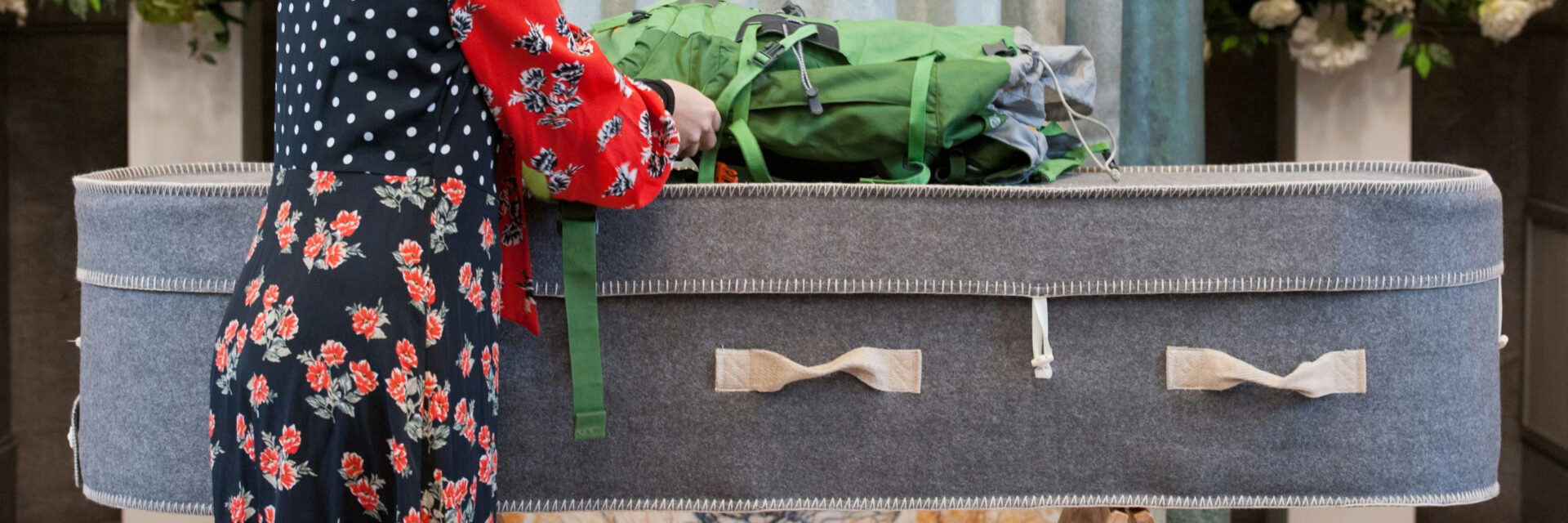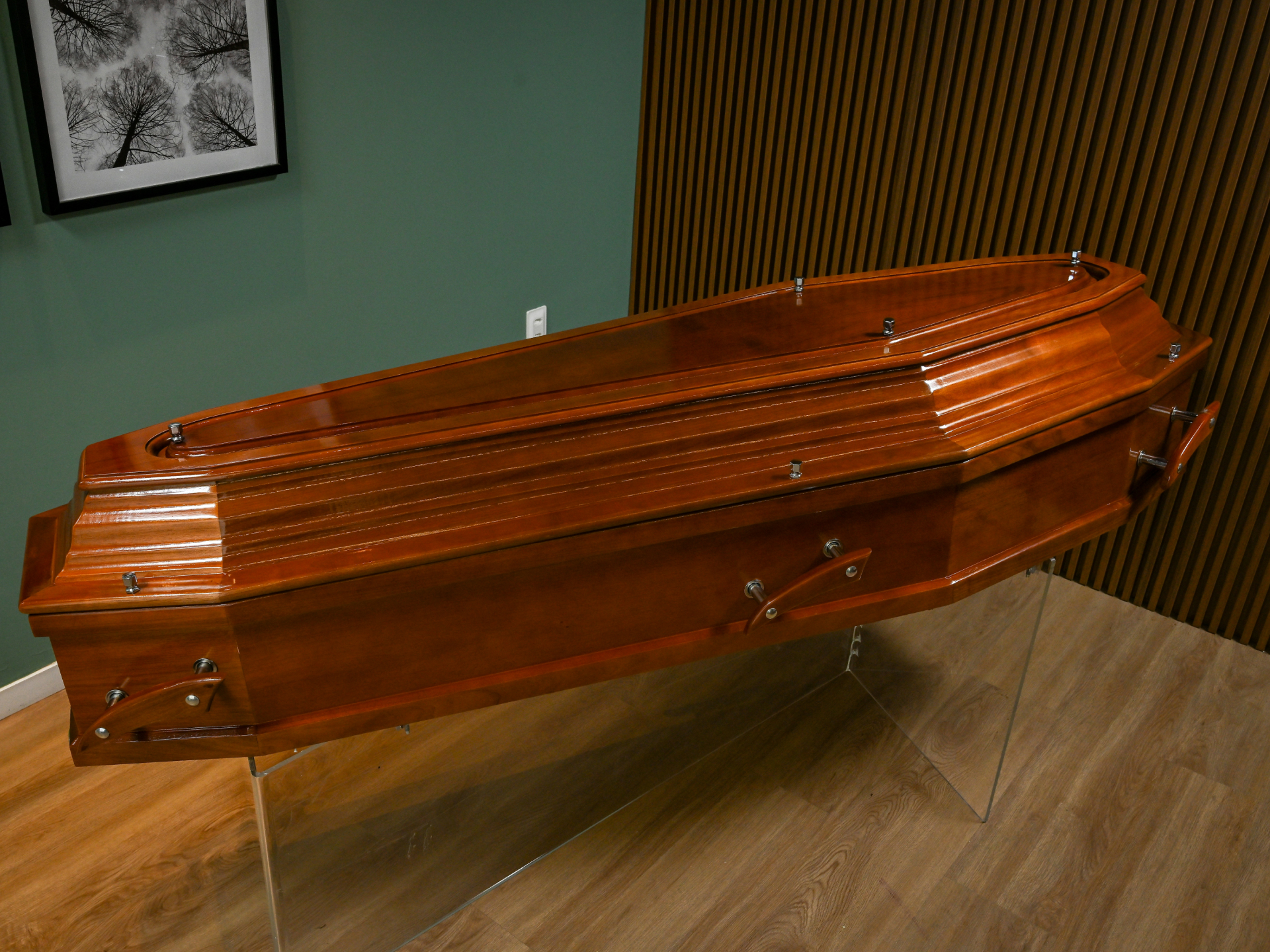
Two Together: Save £100!
Save £100 when you purchase two funeral plans together. Call us for more details.

Two Together: Save £100!
Save £100 when you purchase two funeral plans together. Call us for more details.

9 minute read
Although cremation is a well-known choice, many people still have questions about the process. Do coffins get reused? Will the coffin be burned? This article is here to bring you some comfort, whether you are considering cremation for a loved one or for your own funeral.
You’ll learn what happens to the coffin during the process, why they’re not reused, and discover how ethical standards ensure that each cremation remains a unique and respectful farewell.
Coffins have a practical and symbolic role during a funeral, providing a respectful way to transport and present a loved one for their final farewell. After a person passes away, their body is transported from their resting place to a funeral home so they can be cared for and prepared for the cremation. Here they will be placed inside their coffin before being transported to the crematorium.
During a funeral or committal service, the coffin is usually displayed on a raised platform called the catafalque. This allows mourners to pay their last respects and ensures it is visible during a ceremony. After the service, the coffin is either moved behind curtains or lowered from view as part of the committal.
Coffins for cremation serve a similar purpose to those used in burials: to hold the body of the person who has passed. However, cremation coffins may be made with different materials that are suitable for incineration.

Coffins are not reused for multiple cremations. You may have heard this as a common myth about cremation, but we want to put any fears you may have to rest and assure you it is not true.
Once a coffin is sealed and prepared for cremation, it stays with the body throughout the process. The entire coffin, including any personal items placed inside, will be heated to high temperatures during the cremation process and turned into ash.
At Aura, we collaborate with logistics providers who are members of the National Association of Funeral Directors (NAFD) or The National Society of Allied and Independent Funeral Directors (SAIF). Our partners share our aim to treat every person who needs us with compassion and respect. They handle every step of caring for your loved one with the utmost professionalism and sensitivity.
Coffins used for cremation do not require veneers or treatments, as they do not need to last as long as those used in burials. Cremation coffins are typically made from simple, eco-friendly materials. If a finish is desired for presentation purposes, a light veneer might be applied, but it is kept minimal to reduce emissions during cremation.
When the coffin is transported to the crematorium, it is handled with respect. The coffin may be present for a short service or farewell ceremony, where family and friends can say their final goodbyes. Once the ceremony is complete, the coffin is placed into the cremation chamber, where intense heat ensures the coffin and its contents are respectfully cremated together.
A direct cremation is a way of arranging a low-cost funeral. Although there is usually no ceremony or service, a coffin is still needed. Many providers of direct cremations will include a coffin as a part of their fees.
A direct cremation with Aura includes a simple coffin to offer dignity to the person who has passed. This is provided for unattended direct cremations as well as our attended options which include a short ceremony that allows family members to gather for an intimate and private moment of reflection. The coffin will be present if you wish to add this attended service.
Yes, the coffin is burned during cremation. When placed in the cremator, the coffin undergoes the same high-temperature process, typically reaching around 1000 to 1300 degrees. As coffins are usually made from materials like untreated wood or cardboard, the coffin can even aid in the cremation process, overall reducing the time it takes to cremate a body.
While most of the coffin will burn away and turn to ash, some materials, such as metal handles and nails, may not fully burn. These metal components are carefully removed and disposed of.
There is a common misconception that coffins may be reused for cost-saving or environmental reasons, but legal and ethical standards strictly prevent this. Once a person is placed in their coffin, they will stay together until the cremation. Both the person who has passed and their coffin are entirely consumed by heat in the cremation chamber and nothing—handles, lining, or hardware—is retained or reused.
Another myth about cremation and coffins you may have heard is that multiple cremations happen in a single chamber at the same time. In truth, each cremation is individual. A cremator can only physically accept one coffin at a time and they are thoroughly cleaned in between cremations, ensuring complete separation and dignity.
Most crematoriums in the UK, including those used by Aura, follow a strict code of conduct as laid out by the Federation of Burial and Cremation Authorities.
These standards ensure that crematoriums follow the respectful handling of those who have passed. They include regulations for individual cremations, environmental responsibility, and meticulous care in handling remains, ensuring that coffins are not reused. This provides families with assurance that each cremation upholds the highest ethical and professional standards.
After cremation, the coffin is not recoverable, as it will be mostly turned into ash. The ashes that remain after cremation are processed to reduce any larger bone fragments to fine particles. Any metal components, such as handles or screws, will be collected using a magnet and disposed of once the cremation is finished.
Following the cremation, the ashes will then be placed in a container labelled with the person’s name to ensure accurate identification. Strict regulations require that only one person is cremated in a chamber at a time, with identity checks throughout the process to guarantee the correct handling of each individual’s ashes.
Although many people may choose burial or cremation for religious reasons or personal preferences, this decision can also impact overall funeral costs. In the SunLife Cost of Dying Report, average cremation fees are around £3,795, whereas average burial fees are £5,077.
Cremation is typically more affordable than traditional burial because it doesn’t require a burial plot, headstone, or grave maintenance. These expenses, which are essential for burial, can be quite substantial, especially in areas where cemetery space is limited.
Additionally, cremation often allows for a simpler, more cost-effective approach to choosing a coffin. Cremation coffins can be made from less expensive materials, as they don’t need to withstand the long-term environmental conditions of burial. Cremation also allows families to use a lighter or simpler coffin made of cardboard or simple wood as these are easier to burn. By being lighter and minimalistic in design, they also tend to be less expensive.
The idea of reusing coffins is not widely accepted, as most people find it unsettling and potentially disrespectful. Families expect the coffin chosen for a loved one to be used solely for that person, as it serves as their final resting place.
In addition to being seen as disrespectful to the person who has passed and their family, it could create potential hygiene issues, as coffins that have been used for cremation may carry contaminants. This is why industry standards emphasise using a new coffin for each cremation.
As we become more aware of our impact on the planet, many families are now seeking funeral options that align with their loved ones’ values of sustainability. Ethical and environmental considerations influence decisions around the type of funeral a person may want and their coffin.
Although traditional, solid wood coffins offer a classic appearance, it does come at a cost. They are often made from oak, mahogany, or pine, and this high demand for timber contributes to deforestation and unsustainable growing practices.
The materials and finishes used in traditional coffins also have ecological impacts as they can contribute to harmful emissions when burned, as synthetic linings, heavy finishes, and metal components release pollutants into the air.
Additionally, hardwood coffins that are larger and thicker take longer to burn in an already energy-intensive process. That’s why funeral directors and environmentalists are increasingly advocating for the use of coffins made from sustainably sourced or biodegradable materials, which help reduce the overall environmental footprint of the process.
Choosing a biodegradable or eco-friendly coffin can be important for environmental considerations as well as offering financial benefits. Compared to traditional, more elaborate coffins, biodegradable options are made from natural, sustainable materials like bamboo, wicker, cardboard, or untreated wood. These materials are often less expensive to produce and purchase because they don’t require costly finishes, heavy metals or varnishes that are common in traditional coffins.
Biodegradable, single-use coffins are available to families looking for greener funeral options. Choosing a biodegradable coffin not only reduces the environmental toll of cremation but also supports the global movement toward green funerals. Here’s a look at some popular options:
If you would like to know about Aura’s funeral options and the kinds of coffins we use for direct cremations and our prepaid funeral plans, you are welcome to get in touch or take a look at our FAQs. We are always happy to answer any questions you have.